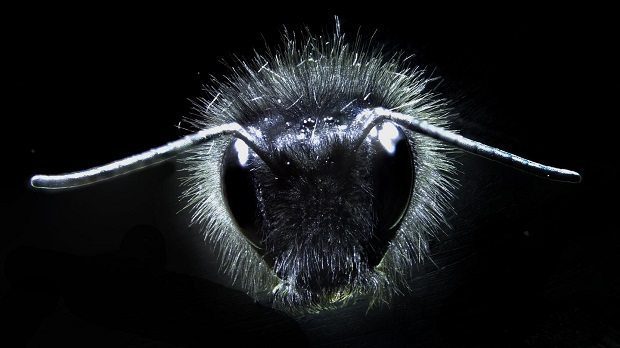[dropcap style=”font-size:100px; color:#992211;”]D[/dropcap]ancing Hairs Alert Electric Bumblebees
Dancing Hairs Alert Electric Bumblebees
Dancing Hairs Alert Electric Bumblebees
DANCING HAIRS ALERT ELECTRIC BUMBLEBEESAHHHGHHHHHH!
*Snarls, throws microphone at bassplayer, removes false teeth, leaves stage*
And as well as being, obviously, an excerpt from a Fall performance, dancing hairs alert electric bees is a concise precis of new research findings from the University of Bristol, detailing an electro-location process by which bumble bees find flowers.
But you knew all that already, yes?
Tiny, vibrating hairs may explain how bumblebees sense and interpret the signals transmitted by flowers, according to a study by researchers at the University of Bristol.
Although it’s known that flowers communicate with pollinators by sending out electric signals, just how bees detects these fields has been a mystery – until now.
Using a laser to measure vibrations, researchers found that both the bees’ antenna and hairs deflect in response to an electric field, but the hairs move more rapidly and with overall greater displacements.
Researchers then looked at the bees’ nervous system, finding that only the hairs alerted the bee’s nervous system to this signal.
The findings, published in the international journal Proceedings of the National Academy of Sciences (PNAS), suggest that electroreception in insects may be widespread.
Electroreception may arise from the bees’ hairs being lightweight and stiff, properties that confer a rigid, lever-like motion similar to acoustically sensitive spider hairs and mosquito antennae.
Dr Gregory Sutton, a Research Fellow in the University of Bristol’s School of Biological Sciences, led the research. He said: “We were excited to discover that bees’ tiny hairs dance in response to electric fields, like when humans hold a balloon to their hair. A lot of insects have similar body hairs, which leads to the possibility that many members the insect world may be equally sensitive to small electric fields.”
Scientists are particularly interested in understanding how floral signals are perceived, received and acted upon by bees as they are critical pollinators of our crops.
Research into these relationships has revealed the co-evolution of flowers and their pollinators, and has led to the unravelling of this important network which keeps our planet green.
Electroreception is common in aquatic mammals. For example, sharks are equipped with sensitive, jelly-filled receptors that detect fluctuations in electric fields in seawater which helps them to home in on their prey.
Source: Eurekalert/University of Bristol
Image: University of Bristol

Some of the news that we find inspiring, diverting, wrong or so very right.




















